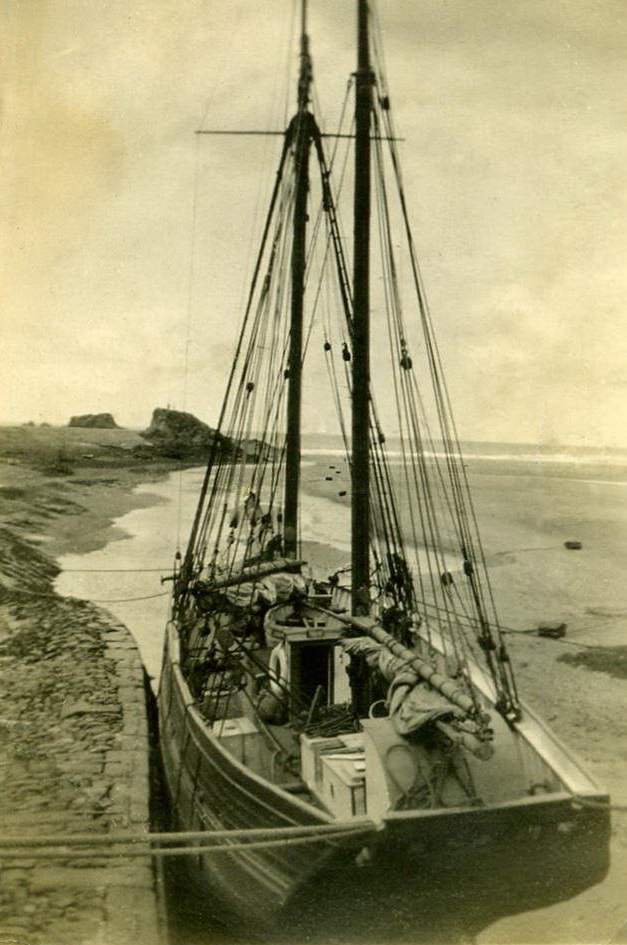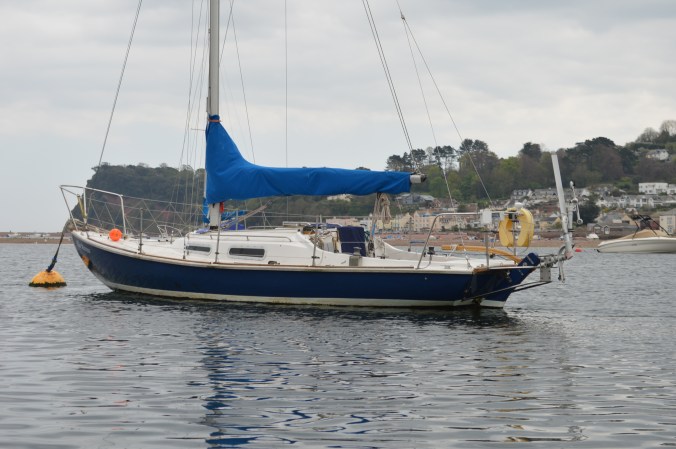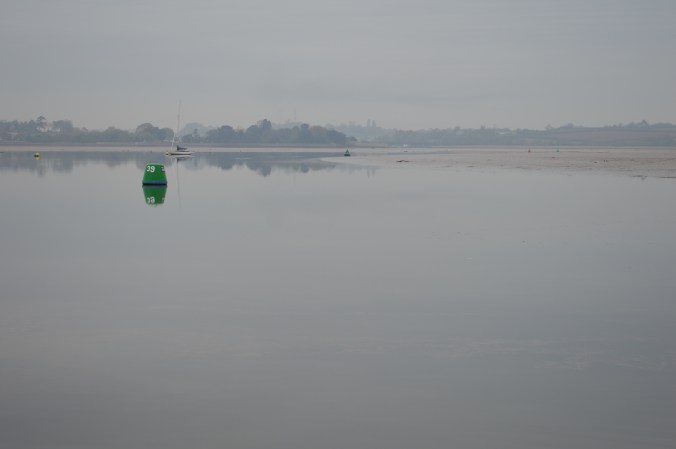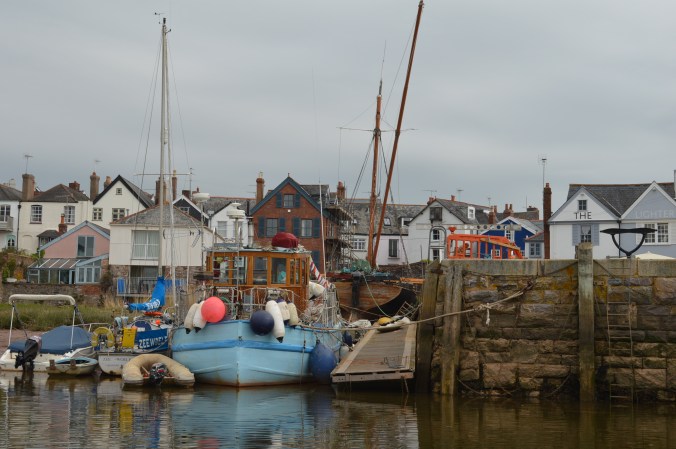
‘Blue Mistress’ is on a mooring at Turf Lock on the Exe Estuary; the wind is getting up and the temperature outside has fallen. There are no other vessels on the moorings here today. I have decided to remain on board, despite the proximity of the Turf Hotel. There are ham and eggs, fruit and beer in the locker for later. For now I have found a biscuit, made a cup of tea and converted the cabin to ‘office’ mode. I am now ‘working’.
Forebears
Elsewhere on this site there are images of and references to the ‘Ceres’, a Westcountry trading ketch, built in 1811. My family acquired her in 1852 and owned her until she sank in 1936. She served a hard working life of 125 years.

‘Ceres’ touched five generations of my family, three of whom owned her. The first of the owners was Captain Henry Petherick, my great great grandfather, then Captain William Petherick, my great grandfather and finally Captain Alfred Petherick, my grandfather. During that time, William’s brother, Captain Walter Petherick, was master of her for over fifty years, and their brother-in-law, Captain Barnabas Shazell, started as an apprentice aboard her, aged 14. The latter married Henry’s eldest daughter. For a while he held shares in ‘Ceres’ before going on to own another trading ketch, the ‘Joseph and Thomas’.
So, five captains from three generations, drawn together by one piece of technology – a wooden sailing ship, together with the knowledge, skills and judgement required to manage that vessel.
One of the features of relatives is that they will be our relations for ever. Whenever I go to sea in my small boat – all 25 feet of it, I ‘carry’ those five captains on board with me. There they are, standing on my cabin top in their great big sea boots, judging how I coil my lines, how I set my sails, how I steer my course. I enjoy sailing ‘alone’ and they are generally good natured about this, but, now and then, one or other will mutter, “The boy’s no more sense than he was born with.”
The Westcountry trading vessels were the bulk carriers of their age – before good roads, railways, lorries. Small ships like ‘Ceres’ – (she was just over 62 feet long), knew intimately the ports, small harbours and beaches of the coasts of Britain, Ireland and the English Channel. Typical cargoes were coal, manure, slate, salt, granite, cement, limestone, iron ore, barrels of resin, fire bricks, general cargo, scrap iron, potash, pine wood, china clay, pipe clay, blue clay, oats, barley or potatoes.
Purpose
My intention, apart from the healthy desire to learn about my forebears, is to gain as much of the knowledge, skills and attitudes of the seamen who sailed in those days as I can, including experiencing the pilotage necessary to enter and leave the ports and harbours they frequented.
For instance, on 27th September 1882, ‘Ceres’, Captain William Petherick, master, left Port Madoc for Exeter, carrying 85 tons of slate. I don’t yet know the date she arrived, but on 19th October, she left Exeter for Bideford, carrying 82 tons of manure; thence in ballast back to Port Madoc, where she picked up another 85 tons of slate for Exeter. She spent Christmas there, and left on 3rd January 1883 for Bideford with 82 tons on manure.
The following winter, on the 18th December 1884, this time Captain Walter Petherick, master, she left Bristol for Topsham carrying 82 tons of manure. She remained in Topsham through that Christmas and left on 17th January for Bideford, carrying, bizarrely, 80 tons of manure.
Gaining experience
This afternoon, I am moored at the locks to the entrance to Exeter Ship Canal, the direct route to Exeter. I am within sight of Topsham (below) and planning to visit there tomorrow.

My own vessel, ‘Blue Mistress’, is, of course, very different from ‘Ceres’. I have the advantage of size in terms of maneuverability and draft, the use of an engine, and no cargo of slate or manure!

But the tides are the same, the currents in the channel, the effects of the weather, the need for careful pilotage – (remembering the above passages were made in the depth of winter). I wonder if ‘Ceres’ was able to sail up with the tide, or whether she was towed by a steam tug – saving time but adding expense. Where did she anchor up? What would the crew have seen on the banks of the estuary? The railway line would have been there, (Brunel’s short-lived Atmospheric Railway had been built in 1847). Powderham Castle was there and some of the older buildings along the way.
The question I am asking now is by this experience, can I learn more of my ancestors attitudes to their life at sea?
Why attitudes?
The wooden sailing ship is a form of technology – (“Technology: the practical application of knowledge especially in a particular area” – Merriam-Webster). In the case of ‘Ceres’, this practical application of knowledge worked for 125 years, and, as I have mentioned, this vessel was known to five generations of my family. We have to look hard these days to find technology that lasts so long. Indeed, many forms of modern technology are outmoded even before we purchase them. Therefore, particularly within Western societies, less is handed down in terms of knowledge, skill and attitudes based on the older technologies. I notice, in particular, my grandson’s ability to use digital technology, and wonder, “Is what he has gained in his access to and mastery of new technology equally matched by access to longer-term human experience passed down through the generations?” And if this is a question involving my grandchildren, it surely equally applies to my yet-to-be-born great grandchildren, and, indeed, my great great grandchildren.
Which raises another question, what is the human experience that is worth passing on? At this very moment, there are three attitudes which would seem to be relevant – namely tolerance, patience and respect. This is why I am looking at the mariners in my family, and wondering about their approach to life. (In the case of seamen, respect means respect for the sea, respect for the vessel and respect for fellow crew members). I don’t believe sailors are innately any more tolerant, patient or respectful than anyone else, but they work in an environment where the absence of such attitudes are soon noticed – and they have to learn to deal with it. There is a loose-tight approach. Sometimes, we must be less tolerant, less patient, less respectful, but always there is a limit. However, there are people, especially some of our leaders, who no longer seem to understand that limit.
So that’s the serious side of why I have made this passage – in fact, why I make any passage. Yes, it’s fun, but it’s more than that.
The ‘work’ I am doing this afternoon is on the transcription of a journal written in 1845 of a voyage from London to Hobart, Tasmania. Some 23 years later, in 1867, young William Petherick made a similar voyage as an able seaman aboard a barque to Shanghai and on to Montreal, before returning to London. Two weeks after he returned, he sat exams in Plymouth for his master’s certificate. He wrote about his voyage. The journal I am copying at the moment describes such a voyage in daily detail.
The ham and eggs, fruit and beer were all good. The day finished with a stunning sunset.

(To be continued)
Colour images by Bill Whateley




















